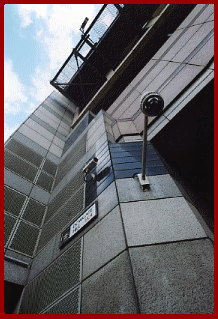| ||||||||||||||||||||||||||||||
Welcome to the | ||||||||||||||||||||||||||||||
 | ||||||||||||||||||||||||||||||
 | ||||||||||||||||||||||||||||||
All you need to know about lenses, | ||||||||||||||||||||||||||||||
The accepted standard focal lengths for various size imagers are:- At long last, Doktor Jon has provided a detailed CCTV lens chart, so at the click of a mouse, you can see exactly which lens can be used on what camera (basic lens selection chart). The next most important consideration for a lens apart from the angle of coverage, is a phenomenon known as ‘Depth of Field’. This is an extremely important concept to grasp, not least because when taken alongside Doktor Jons principle of the ‘Cone of Containment’, it is essential to not only align a camera to the general directional movement of a target, but also to try and achieve a sharp image throughout. If you focus a camera on a distant (movable) point of light, the image on the pick up device will hopefully be nice and sharp. Without adjusting the focus, slowly move that same point light source towards the camera and it will gradually begin to blur, and eventually disappear as a point, to be replaced by a light patch. Where the point begins to de-focus, the wonderfully inventive technical term for this is a “Circle of Confusion”. The trick with any image to be focussed, is to try and minimise the circles of confusion, so that most of the picture is either very crisp, or at least acceptably sharp. Remember there are actually two main reasons for out of focus images; one being lack of optical focus, and the other being significant target speeds (the third, which is a camera moving because it hasn’t been secured properly, shouldn’t really need to be mentioned!). Now the idea behind Depth of Field, or as some people prefer to call it Depth (or Zone) of Focus, is that with any lens set at maximum aperture, the wider the lens coverage (i.e. the shorter the Focal Length), then the greater the Depth of Field. In fact on some Ultra Wide lenses, the DoF is so extreme that the lens does not require a focussing ring; everything from one to one thousand metres in front of the camera is in focus, all the time! How brilliant is that!! The only draw back with this type of lens, is that you only need your target to move a relatively short distance away from the camera, and then it becomes too small to recognise - just goes to prove, there really is no such thing as a free lunch! | ||||||||||||||||||||||||||||||
 | ||||||||||||||||||||||||||||||
IMPORTANT: No material may be reproduced, copied or redistributed from this site, © doktorjon.co.uk 2004 - 2008 Homepage...:...Gateway...:...Technical Gateway....:....Quickfind Index....:....Equipment Directory | ||||||||||||||||||||||||||||||

